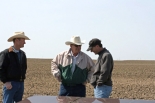The renewable energy gold rush is on
A billion-dollar power plant is proposed for Carrizo Plain
By John McReynolds[{
"name": "Ad - Medium Rectangle CC01 - 300x250",
"id": "AdMediumRectangleCC01300x250",
"class": "inlineCenter",
"insertPoint": "8",
"component": "2963441",
"requiredCountToDisplay": "12"
},{
"name": "Ad - Medium Rectangle LC01 - 300x250",
"id": "AdMediumRectangleCC01300x250",
"class": "inlineCenter",
"insertPoint": "18",
"component": "2963441",
"requiredCountToDisplay": "22"
},{
"name": "Ad - Medium Rectangle LC09 - 300x250",
"id": "AdMediumRectangleLC09300x250",
"class": "inlineCenter",
"insertPoint": "28",
"component": "3252660",
"requiredCountToDisplay": "32"
}]
OptiSolar, a Hayward-based startup with roots in the oil sands of Canada, is proposing to build a colossal photovoltaic electricity generation farm on 6,000 acres in the Carrizo Plain, the company announced last week. The installation would yield 550 MW of power, enough to serve 190,000 homes, and would cost $1 billion dollars to construct.
|
|||
| PHOTO COURTESY OF OPTISOLAR |
The massive scale of OptiSolar’s Topaz Solar Farm dwarfs the 177 MW solar thermal plant trumpeted in November by Ausra of Palo Alto. OptiSolar’s plan involves more than double the investment, three times the output, and nearly 10 times the land area. The Topaz hardware will cover the flat plain from hillside to hillside two miles north of Highway 58. And it may grow larger.
“We’re not trying to be better than the next guy,” said Executive Vice President Phil Rettger, an amiable 40-something sporting a cool company ball cap and an MBA from Harvard. “We just want to contribute to renewable energy in California.”
And probably earn a dollar or two. Rettger and OptiSolar CEO Randy Goldstein founded OPTI Canada 15 years ago and nursed it into a $4 billion operation targeting coal gasification in Alberta. OptiSolar and OPTI Canada have similar names and several board members in common, but are separate corporations.
The Carrizo facility would comprise 1,100 five-acre blocks of solar panels. Dark brown panels the thickness of window glass would lay waist high on concrete supports tilted toward the south. Each panel would have on its underside an invisible film of amorphous—not crystalline—silicon.
“Amorphous silicon uses 100 times less silicon than the crystalline used on rooftops,” Rettger explained.
There will be 1,100 SUV-sized inverters, one for each block, to convert the DC current created in the panels to AC before it’s transmitted underground to a PG&E substation. The only other structure will be a mobile home to serve as an office, Rettger said. There will be no moving parts, no noise, no use of water. This is a dramatic difference from the solar thermal design proposed by Ausra, which would heat water to turn a turbine.
Rettger claimed that a three-foot gap between each panel would allow grass to grow and wildlife to move freely. He estimated that the panels would cover only 50 percent of the ground area.
“There will be protected space under the panels,” he added.
The area now supports wild pigs, antelopes, coyotes, kit fox, and even elk.
Rettger presented no environmental documents, but said they would accompany the firm’s application next month for a county Conditional Use Permit.
“This is not a solar thermal project, so it does not fall under state energy commission jurisdiction,” he said.
He also stated that the land, though not the panels, will be subject to local taxation: “Our understanding is that the land would be reassessed,” he said with a smile.
The Ausra project will not pay local levies.
Rettger estimated that permitting might be completed soon enough to allow work to begin late in 2009. Construction would involve 200 to 300 workers, but long-term maintenance would require no more than 10 on staff.
The company, unlike most of its competitors, will manufacture its own cells. It has a manufacturing plant in Hayward and plans a new factory in Sacramento. The Hayward facility is ramping up now to produce cells for OptiSolar’s first solar farm, a 50 MW operation about to break ground in Sarnia, Ontario, Canada.
Rettger would not elaborate about the manufacturing methods he said allow his firm to mass produce the new amorphous type of cells, nor would he disclose his principal investors. He said the company doesn’t yet have a contract with any utility.
He hinted that the firm was looking at more land purchases, but he wouldn’t say how many, or where, though sources tell New Times that Carrizo is abuzz with rumors of OptiSolar representatives, or those of other firms, expressing interest in acquisition.
“People see this as a less objectionable alternative,” reported former county Supervisor Jerry Diefenderfer, comparing OptiSolar to Ausra. “It’s not going to use water. It’s closer to the ground. It’s not going to make noise, and it’s away from the highway.”
The site is nine miles from the Carrizo Plain National Monument.
The gold rush of deep-pocketed investors has been triggered by a California law requiring utilities to purchase 20 percent of their electricity from renewable sources by 2010.
A third firm, SunPower of San Jose, is also eyeing the Carrizo area. According to John McKenzie of the county planning department, SunPower envisions a 250MW photovoltaic farm on six square miles north of California Valley but southeast of the sites of Ausra and Optisolar.
Skyrocketing oil costs have made solar power cost competitive. As Carrizo rancher Darrell Twisselman, who is selling land to OptiSolar, declared last week, “When gas costs more than a gallon of milk, something has to change.”
Freelancer John McReynolds can be reached via [email protected].
Latest in News
Readers also liked…
-

Coast Unified teachers upset over new position's salary and qualifications
Oct 20, 2022 -

SLO police identify alleged driver who hit and killed couple
Dec 22, 2022 -

When the levee breaks: Oceano residents, county officials walk a tightrope of regulations to manage Arroyo Grande Creek, which some say led to the levee's failure in January
May 18, 2023









